I’ve been completely reworking the BlogTV system, so I thought a few tech notes were in order. I’ve released most of my streaming video methods to the public, the methods rely on commercial software but there are other ways to do the job. This is just one of them.
There were some big problems with the last video, I found out I made some tiny miscalculations cropping the video, the codec insists the video be resized to exactly 50% with pixel heights in multiples of two. I did everything about .001% wrong, causing the video to crash when played. But I appear to have the problem under control now.
I got a lot of hits from the Jobs video, and I had to limit the system to 5 streams. This may force me to change the way I put the videos in the blog. This is the first time I’ve had so many videos up on the monthlong page, if I put up 6 videos on the page at once, it will error every time it loads, thinking it doesn’t have enough bandwidth to stream more than 5 videos at once. This could be a problem. I’ve been playing with some of the fancy in-window player systems, but the coding is virtually incomprehensible. I think people use something like Livestage Pro for this, ooh it’s expensive.
I just upgraded to QuickTime 6.2 and QuickTime Streaming Server 4.1.3. I was worried about how well they would run on my ancient G3/400 server, but it was a smooth upgrade. With the new QT6.2, I’m considering using MP4 encoding for the videos, but preliminary experiments don’t look good. I’ve gone to a lot of trouble to tune the video codecs so you can see subtitles clearly, and the MP4 codecs are weak on fine detail, the subtitles show a lot of artifacts and become illegible. If I can work this one problem out, it looks like MP4 is the way to go. MP4 will require QT6, I hate to force upgrades but QT6 has been out for ages. It’s a big download for a 56k modem user, but they will probably benefit more than broadband users.
I noticed that SCOLA has been providing a better signal lately. I usually have to adjust the brightness up and the contrast down, but I’m working on a new video and it didn’t require any adjustment at all. I have no way to preview these videos on a wide range monitors, so if you think the video is too dark or too bright, or bad contrast, please let me know and tell me what platform and monitor you’re using. Thanks.
Category: General
The Fall and Rise of Reginald Perrin
My favorite comedy TV show, The Fall and Rise of Reginald Perrin is back on the air and I am jumping for joy. The show first aired in 1976 and I remember seeing it back then and declaring it the funniest show ever. Reginald Perrin may have warped my mind more than any other TV show, more than Monty Python or any of the other deranged shows I used to watch. There’s no possible way to explain the show so you just have to see it. Be sure to watch it Sunday nights at 10:30PM on IPTV.
MovableType 2.63 Upgrade
Disinfotainment was down for a few minutes while I upgraded my MovableType setup to version 2.63. I seem to have all the old content and comments back in place, but reset to the default templates. I’ll have to rebuild the templates properly, and do a few things right like I should have done in the first place. And now I can experiment with some new features like Trackback. It might get a little messy around here for the next few days.
Check Sheet
When I lived in Japan, I used to commute to school every morning on trains packed with kids on their way to school. I noticed many of the High School students were doing the strangest things, they all had little red and green pieces of plastic and little sheets of paper. I asked them about it and they said it was a Check Sheet, and they showed me how to use it.
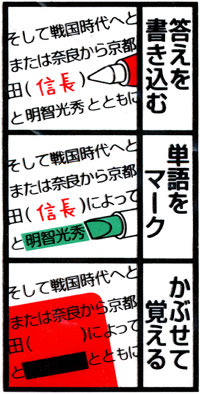
The Check Sheet is a simple study aid, widely used in cram schools in Japan. There are several variations but this illustration from the back of a Check Sheet package should explain the basic idea. The Check Sheet itself is a transparent rectangle of red plastic, usually about the width of a page. The Check Sheet system includes red and green pens and highlighters. You can see from the illustration that if you write in red, when you hold the red filter over it, the red text will be invisible. Use a green highlighter to cover a word, the red filter will make it opaque black. Very clever. There is a second type of Check Sheet, it is a bar of two strips of plastic, one red and one green. You can use the green side of the sheet, and the effect is exactly opposite, the green pen is transparent and the red ink is opaque.
I used to see kids cramming lists of English vocabulary written on little strips of paper. They would write a list of vocabulary words in English in red pen, and the Japanese definitions in green pen. They held the list under the Check Sheet, guessed each word, and then slid the sheet down one entry so the word popped up from the edge of the sheet, unfiltered, revealing the answer. Then you flip the ruler upside down and use the green side, and go down the list of definitions, written in green and now invisible. Very very clever. I liked this scheme so I bought some Check Sheets and the special pens, but I was unable to find the proper green pens and highlighters so I just used the red pens.
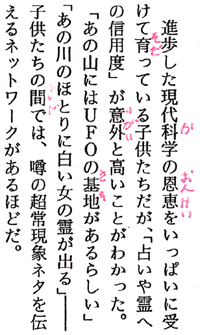
Here’s a little sample of my furigana notes from a textbook I was using when I discovered the Check Sheet. My teacher would get furious if we put furigana notations in our textbooks. We would read these passages aloud in class, and if we had pronunciation hints, he thought it was cheating. But with the Check Sheet, I could keep the furigana concealed, only revealing it when I got stuck. I could practice it over and over, sliding the sheet to the left to reveal the hints as needed, eventually I would not need the hints. This study method seemed to satisfy the teacher as non-cheating. Sheesh! But the teacher may have had a point. Furigana is a crutch. You need margin notes but you need some way to make them fade away so you can do it the hard way and get proper practice.
You can adapt the red/green filters to your own study methods in a variety of ways. Any red or green plastic will work fine, but the Japanese plastic rulers can sometimes be obtained at specialized Japanese stationery stores. The Check Sheet pens are perfectly matched to the filters, you must use exactly the right color or the ink doesn’t go fully invisible. But the official Check Sheet pens can be hard to find so you may need to find a substitute. I found that art supply stores have “designer markers” in fine gradations across the color spectrum, and it was not hard to find a matching red and green felt tip markers that worked with the Check Sheet.
I think the Check Sheet system is particularly well adapted for Japanese second language learners, because they have the triple task of learning vocabulary with three parts: the meaning, the kanji, and the reading (pronunciation). I often joke that studying Japanese vocabulary requires three-sided flash cards. But with the red/green Check Sheets plus red/green pens and highlighters, you actually have 8 ways to conceal and reveal information. Just pick which 3 work the best for your context, and you have the functional equivalent of three-sided flash cards.
A Voice from the Grave
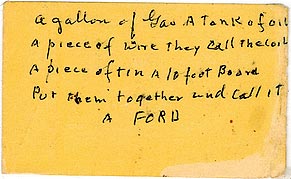
My Aunt is visiting, we were swapping horror stories about the Ford automobiles we had owned, when she suddenly said she had a handwritten Post-it note from my late Grandfather. She laminated it and keeps it in her wallet. If you can’t read the shaky handwriting, it says:
a gallon of gas A Tank of oil
A piece of wire they call the coil
A piece of tin A 10 foot Board
Put them together and call it
A FORD
Technomorphia
I was arguing today (well, bickering actually) about whether a Mac or Wintel PC was the right tool for a particular job, and I was suddenly reminded of an extremely eccentric art history lecture I attended almost 30 years ago.
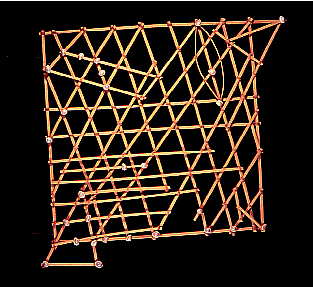
When the lecture began, a slide very similar to this photograph was projected on the screen at the front of the hall. The lecturer asked the students if they could guess the purpose of this object, and where it originated. We could see the small seashells at some of the intersections of the sticks, eventually someone guessed correctly that it originated in the Pacific Islands near Asia. But nobody even came close to identifying the object’s purpose.
Eventually the lecturer revealed that the object is a navigational map of the ocean, a Micronesian Stick Chart. The sticks represent ocean currents and the seashells represent islands, but the map’s distances are not accurate on a geographic scale, they are scaled to the time it took to travel the ocean currents between the islands. Suddenly it all made sense. But then the lecturer veered off into incomprehensible, uncharted territory for us poor art students.
The lecturer asserted this object was the embodiment of “technomorphia.” The object was made from the conveniently available local materials, sticks and shells, and was better suited to being carried in small seafaring boats than paper maps. He pointed out that the Micronesians had not yet learned to make paper at the time these maps were invented, but even after they learned the papermaking secret, they still preferred the Stick Charts over paper maps. Sticks and shells don’t get soggy in seawater, and can be mended easily. He rambled on about technomorphic aspects of this artform, and how it developed in the cultural context of Micronesia. I didn’t understand much of it, and neither did anyone else.
This particular lecturer was notorious for using incomprehensible jargon, sometimes he even made stuff up as he went along, so I always took notes and asked him for definitions after the lecture was over. I challenged him on technomorphia, and asked him to explain further. He talked about how the tools and materials available determined the forms the artwork would take. He talked at length about how technomorphia affected each separate media (i.e. printmaking, painting, photography) and how each media’s expressive possibilities were achieved despite the limitations of that media. I responded, “oh, you mean, when you only have a hammer, every job looks like a nail.”
A Steaming Pile of Craphound
I’m observing one of the Blog world’s more stupid rituals, by publicly announcing the removal of a link from my site. I have removed Boing Boing magazine from my blogroll.
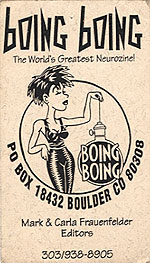
Boing Boing used to be a pretty good zine about 15 years ago, back when it was solely the product of Mark and Carla. But now it’s been completely taken over by Cory Doctorow, who is a complete and utter asshole. Mark and Carla’s “neurozine” is now infested by Cory’s self-promotion activities, at times the site has been almost 100% advertising for Cory’s new SF scribblings. Sure you have a right to use your site for self-promotion, but this is beyond the pale. Cory has his own site, I don’t know why Mark let Cory take over his pet project and use it for his own purposes.
I think my main distaste for Cory comes from his unhealthy obsession with Disneyworld. I got into a flamefest with him about something he did at Disneyland and wrote about on BoingBoing. He said he gathered a large group of online acquaintances to go to Disneyland as a group, including a woman in a wheelchair. They used the handicapped woman to cut the WHOLE GROUP into the front of the line on the rides. I told him he was exploiting the woman’s handicapped status for his group’s personal gain. He retorted that Disneyland wants handicapped people and their friends to be able to experience Disney attractions together. I wasn’t aware you could get 20 or 30 people into a single car on a roller coaster ride. He said the handicapped woman didn’t mind being exploited. What a load of crap!
And there’s the problem. Cory is a self-proclaimed craphound. I think he’s just full of crap. There’s a fine line between admiration for crappy pop culture detritus, and obsession. Cory is obsessed, he’s the ultimate Comic Book Guy. I won’t refer readers to the site, they have enough links. Life is too short to put up with self-important idiots like Cory.
Tax Day at the Terminal Annex
I used to live about 6 blocks south of the US Post Office Terminal Annex in Downtown Los Angeles. The Terminal Annex is literally the terminal location for all mail in the LA area, it’s located at the conjunction of all the major highways and railroad lines in LA, and it takes incoming mail from trucks across LA. All outgoing mail ends up here before it is sent outside the city. The TA also has one unique property, it is the last place you can get a letter postmarked until midnight, since it is the only annex open until midnight. For that reason, the TA has become a traditional spot for dropping off your tax returns on April 15.
On Tax Day, streets around the TA are completely impassable for blocks in every direction. It is a scene of total pandemonium, total gridlock with hundreds of cars full of fuming, desperate late-filers. Scattered throughout the cars were roving homeless people offering to take your tax return the final blocks for a fee of $1. I saw one homeless bum on roller skates, I bet he made a lot of money. But you’d have to be a total idiot to hand your tax returns to a homeless bum, I wouldn’t give it to anyone except an agent of the US Post Office.
Every year, I had to cross this massive traffic jam just to drive home, there were no alternate routes I could take to avoid the mess. I remember one year it took me over an hour to cross the four lanes of Alameda Blvd, I had to nose my car in front of crossing (but immobile) traffic. The guy I cut in front of wanted to drag me out of my car and start a fistfight because he thought I was jumping in line, I explained I lived across the street and he would have his precious spot back as soon as I crossed. I was surprised to see how much pent-up anger this crowd of late-filers had.
The Terminal Annex is no longer the terminal spot for all mail in LA. Its functions have been broken up and decentralized, moved to other annexes in the city. There are many other places that can postmark late tax returns until midnight, but the Terminal Annex is still the traditional spot for dropping off your tax return. I’m sure that tonight’s LA TV news shows will be broadcasting live from Alameda Blvd in front of the Terminal Annex, just as they always do.
Not Yet Coming Attractions
I heard a strange new commercial pitch for a weekly TV drama, it said “4 all-new episodes coming up in only 2 weeks!” That certainly is the most original pitch I ever heard. I prefer to think of it as an announcement that the next 2 weeks would be reruns, with no new episodes until May sweeps.
What ever happened to the TV schedule? It used to be the networks would run a fall season of new episodes and then they’d replay them again as summer reruns. But somehow that changed, nowadays the scheduled shows default to reruns, and a new episode is a special event.
White Toilet Paper
Environmentalists used to take it as an item of faith that you should buy only undyed, plain toilet paper, tissues, and paper towels. Ideally you would buy unbleached papers, which would reduce some of the dioxin pollution involved in papermaking, but people just won’t buy unbleached toilet paper. Our local hippie coop sells recycled unbleached paper TP with the unfortunate brand name “Second Use Recycled Toilet Paper.” I insist on being the absolutely first and only user of this type of product.
The theory behind eliminating unnecessary dyes is that these papers are purchased as garbage, you buy them specifically for flushing or throwing them away. Sure you want to have a nice little colorful border pattern on your paper towels or TP as it hangs there on the dispenser, otherwise the additional dyes serve no functional purpose. But when you consider the millions of tons of these paper waste products going directly into landfills every year, it doesn’t make any sense to add hundreds of tons of waste dyes along with it.
Lately I’ve had a hard time buying plain white paper towels and tissues. I go to the grocery store and they only have dyed “designer” Kleenex in beige or blue, and paper towels with printed borders, they have no white products at all. Apparently over the years, consumer resistance to colored kleenex and other products has been breaking down. I guess you can sell any kind of crap to people if you introduce it gradually.
It’s not hard to find TP in white, as long as you want double or triple-roll 12 packs. I don’t know where to store it all. I bought a Northern double-roll 6 pack today because it was the smallest the store had. When I got to the checkout, the checker said it was only 10 cents more to get the 12 pack of double rolls, I should swap. So I did. But I draw the line at triple-rolls.